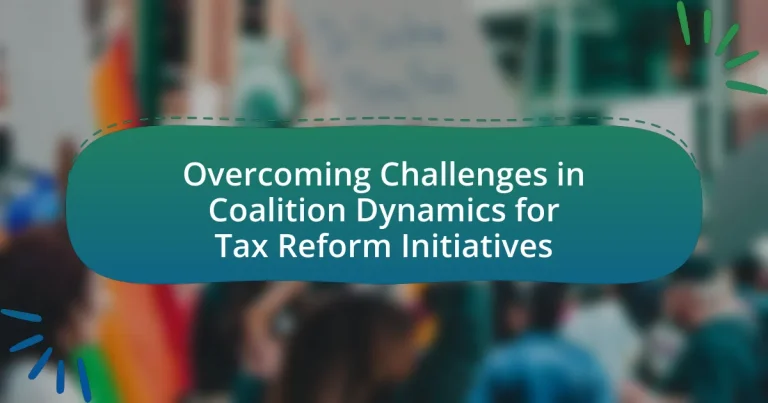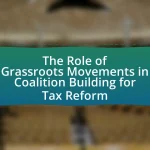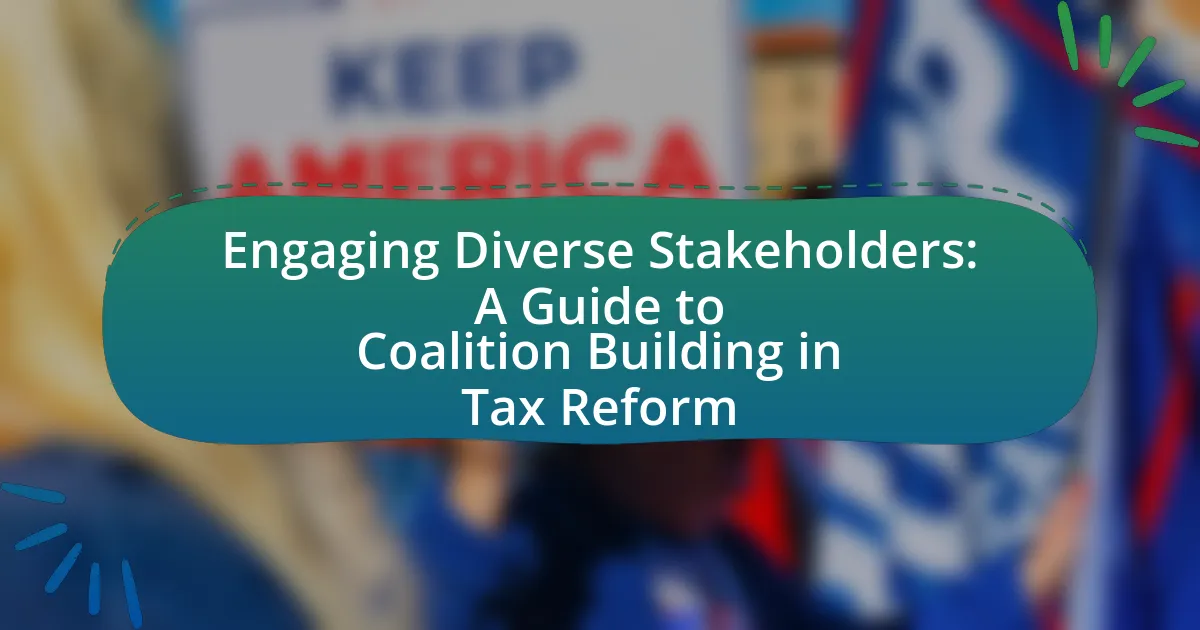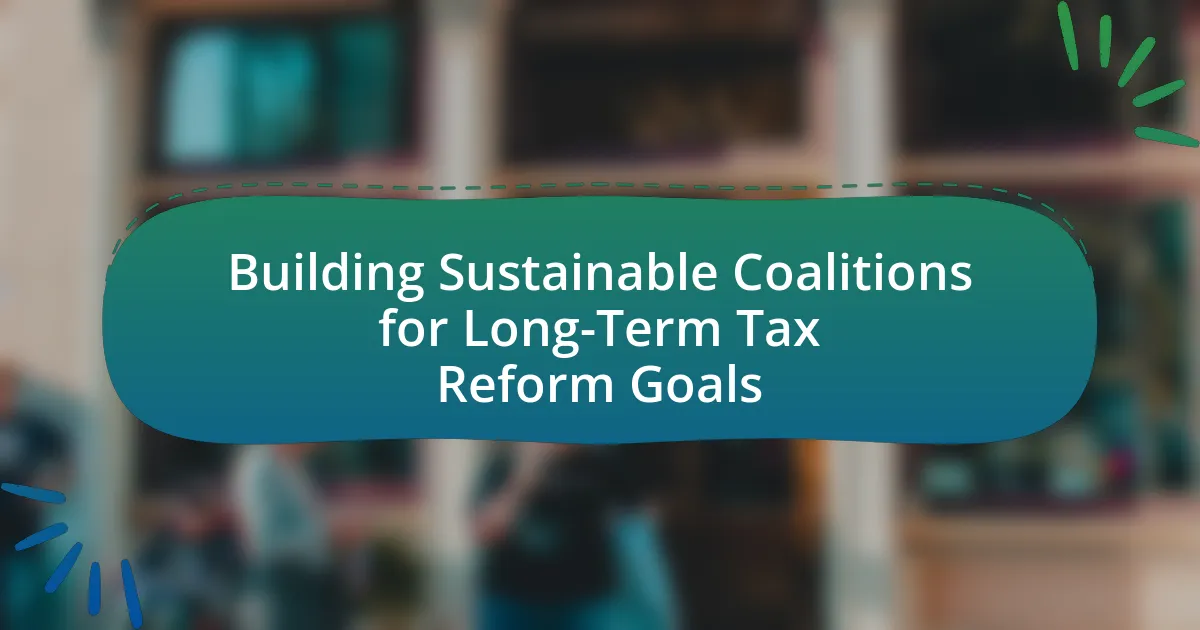The article focuses on overcoming challenges in coalition dynamics for tax reform initiatives, highlighting key issues such as divergent interests among stakeholders, communication barriers, and the complexity of policy design. It examines how differing interests impact tax reform efforts, the specific interests various stakeholders bring to coalitions, and strategies for reconciling conflicts. The importance of effective communication, transparency, and strong leadership in fostering collaboration and consensus-building is emphasized, along with best practices for engaging stakeholders and establishing clear goals. Historical examples and case studies illustrate successful coalition dynamics, providing lessons for future tax reform initiatives.
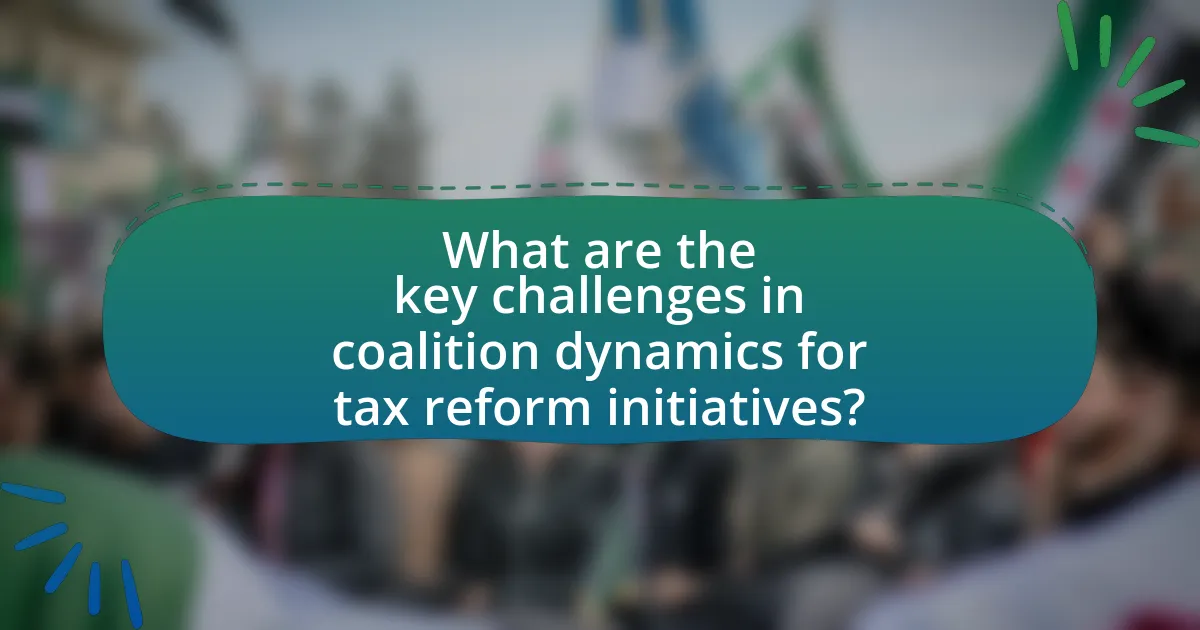
What are the key challenges in coalition dynamics for tax reform initiatives?
The key challenges in coalition dynamics for tax reform initiatives include divergent interests among stakeholders, communication barriers, and the complexity of policy design. Divergent interests arise when coalition members prioritize different tax objectives, making consensus difficult. Communication barriers can hinder effective collaboration, as varying levels of expertise and understanding among members may lead to misunderstandings. Additionally, the complexity of tax policy design requires technical knowledge, which can create further divisions within the coalition. These challenges are evidenced by historical tax reform efforts, such as the 2017 Tax Cuts and Jobs Act in the United States, where conflicting interests among Republicans and Democrats complicated the legislative process.
How do differing interests among coalition members impact tax reform efforts?
Differing interests among coalition members significantly hinder tax reform efforts by creating conflicts that complicate consensus-building. When coalition members prioritize their unique agendas, such as economic equity, business interests, or fiscal responsibility, it leads to divergent goals that can stall negotiations. For instance, a coalition aiming for comprehensive tax reform may struggle if some members advocate for higher taxes on corporations while others push for tax cuts to stimulate growth. This discord can result in fragmented proposals that lack the necessary support to pass legislation, as seen in various historical tax reform attempts where competing interests led to watered-down compromises or complete failures.
What specific interests do various stakeholders bring to the coalition?
Various stakeholders bring distinct interests to the coalition focused on tax reform initiatives. For instance, government representatives seek to enhance revenue generation while ensuring equitable tax policies. Business leaders aim for tax incentives that promote growth and competitiveness. Non-profit organizations advocate for social equity, pushing for tax reforms that benefit low-income populations. Additionally, economists contribute data-driven insights to support sustainable fiscal policies. These interests collectively shape the coalition’s agenda, driving collaborative efforts toward effective tax reform.
How can conflicting interests be reconciled within the coalition?
Conflicting interests within a coalition can be reconciled through negotiation and compromise. Effective communication among coalition members allows for the identification of common goals, which can serve as a foundation for resolving differences. For instance, research by the Harvard Negotiation Project emphasizes the importance of interest-based negotiation, where parties focus on underlying interests rather than positions, leading to mutually beneficial solutions. Additionally, establishing clear decision-making processes and fostering a culture of collaboration can help align diverse interests towards shared objectives, ultimately enhancing the coalition’s effectiveness in tax reform initiatives.
Why is communication crucial in coalition dynamics for tax reform?
Communication is crucial in coalition dynamics for tax reform because it facilitates alignment among diverse stakeholders, ensuring that all parties understand the objectives and strategies involved. Effective communication helps to clarify roles, responsibilities, and expectations, which is essential in a coalition where differing interests and perspectives exist. For instance, research by the Brookings Institution highlights that successful coalitions in tax reform often rely on transparent dialogue to build trust and foster collaboration, ultimately leading to more effective policy outcomes.
What communication strategies can enhance collaboration among coalition members?
Effective communication strategies that can enhance collaboration among coalition members include establishing clear communication channels, fostering open dialogue, and utilizing collaborative technologies. Clear communication channels ensure that all members are informed and aligned on goals, which is crucial for maintaining focus and unity. Open dialogue encourages the sharing of diverse perspectives, leading to more innovative solutions and stronger relationships among members. Collaborative technologies, such as shared platforms for document management and communication tools, facilitate real-time collaboration and information sharing, which is essential for coordinating efforts in complex initiatives like tax reform. These strategies are supported by research indicating that effective communication significantly improves coalition effectiveness and member satisfaction, as highlighted in studies on coalition dynamics and collaborative governance.
How does transparency affect trust within the coalition?
Transparency enhances trust within a coalition by fostering open communication and accountability among its members. When coalition members share information freely, it reduces uncertainty and builds confidence in each other’s intentions and actions. Research indicates that coalitions characterized by high transparency experience stronger collaboration and commitment, as members feel more secure in their roles and contributions. For instance, a study published in the Journal of Business Ethics found that transparency significantly correlates with trust levels in organizational settings, demonstrating that clear communication and openness lead to increased trust among team members.
What role does leadership play in overcoming coalition challenges?
Leadership is crucial in overcoming coalition challenges as it provides direction, fosters collaboration, and resolves conflicts among diverse stakeholders. Effective leaders establish a shared vision that aligns the interests of coalition members, facilitating cooperation and commitment to common goals. For instance, during the 2017 U.S. tax reform efforts, leaders like Speaker Paul Ryan navigated differing priorities within the Republican Party by promoting a unified message, which helped to mitigate internal disputes and maintain coalition integrity. This demonstrates that strong leadership not only addresses immediate challenges but also builds trust and cohesion, essential for the success of complex initiatives like tax reform.
What qualities should leaders possess to effectively manage coalition dynamics?
Leaders should possess strong communication skills, emotional intelligence, and adaptability to effectively manage coalition dynamics. Effective communication fosters transparency and trust among coalition members, which is essential for collaboration. Emotional intelligence allows leaders to understand and navigate the diverse perspectives and motivations within the coalition, facilitating conflict resolution and consensus-building. Adaptability enables leaders to respond to changing circumstances and stakeholder needs, ensuring the coalition remains focused on its goals. Research by the Center for American Progress highlights that successful coalitions in tax reform initiatives often rely on leaders who can engage diverse stakeholders and maintain alignment through effective communication and emotional awareness.
How can leaders facilitate consensus-building among diverse groups?
Leaders can facilitate consensus-building among diverse groups by actively promoting open communication and fostering an inclusive environment. This involves creating platforms for dialogue where all voices are heard, ensuring that differing perspectives are acknowledged and respected. Research indicates that inclusive decision-making processes lead to higher satisfaction and commitment among group members, as seen in studies by the Harvard Business Review, which highlight that diverse teams outperform homogeneous ones in problem-solving and innovation. By employing techniques such as collaborative brainstorming sessions and structured feedback mechanisms, leaders can guide diverse groups toward shared goals, ultimately enhancing the effectiveness of coalition dynamics in tax reform initiatives.
How can coalition dynamics be improved for successful tax reform initiatives?
Coalition dynamics can be improved for successful tax reform initiatives by fostering open communication and establishing clear goals among stakeholders. Effective communication ensures that all parties understand the objectives and concerns of others, which can lead to greater collaboration. Research indicates that coalitions with defined goals and regular updates are more likely to achieve consensus, as seen in the successful tax reforms in countries like Canada, where stakeholder engagement was prioritized. Additionally, utilizing data-driven approaches to demonstrate the benefits of proposed reforms can align interests and build trust among coalition members, further enhancing cooperation.
What strategies can be employed to strengthen coalition effectiveness?
To strengthen coalition effectiveness, establishing clear communication channels is essential. Effective communication fosters transparency, aligns goals, and enhances trust among coalition members. Research indicates that coalitions with regular, structured communication meetings report higher satisfaction and engagement levels, leading to improved collaboration. Additionally, defining shared objectives and roles within the coalition ensures that all members understand their contributions, which is critical for maintaining focus and accountability. A study by the National Academy of Sciences highlights that coalitions with well-defined roles are 30% more likely to achieve their objectives compared to those without. Implementing these strategies can significantly enhance the overall effectiveness of coalitions, particularly in complex initiatives like tax reform.
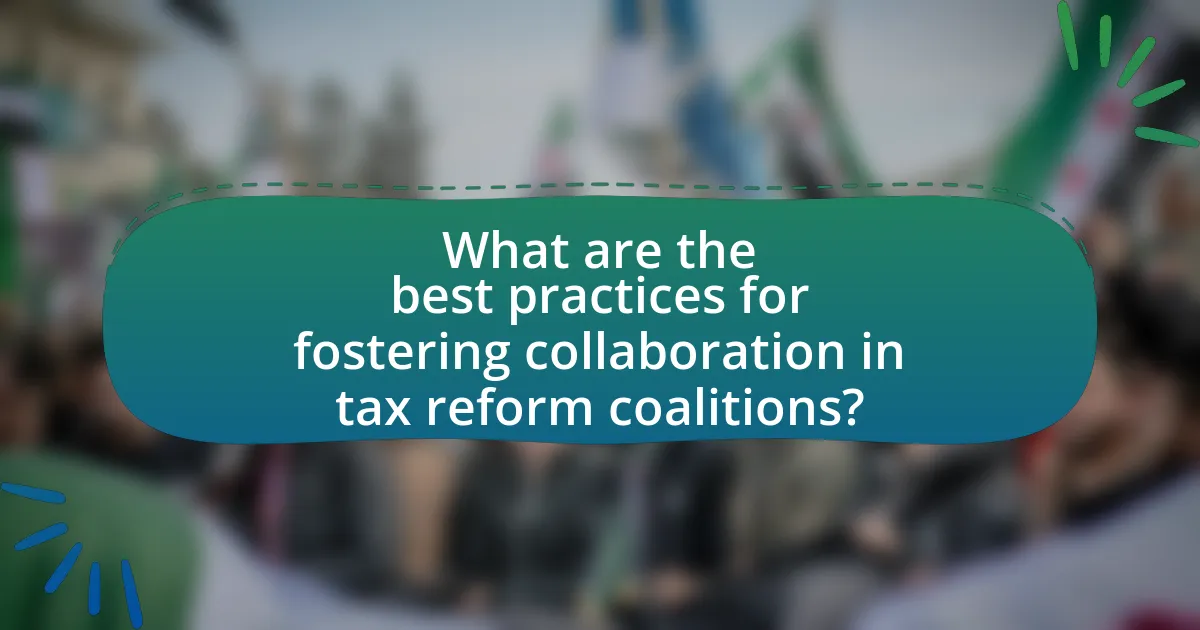
What are the best practices for fostering collaboration in tax reform coalitions?
The best practices for fostering collaboration in tax reform coalitions include establishing clear goals, ensuring open communication, and building trust among members. Clear goals provide a shared vision that aligns the coalition’s efforts, while open communication facilitates the exchange of ideas and feedback, essential for addressing diverse perspectives. Trust is crucial as it encourages members to engage fully and share resources, leading to more effective collaboration. Research indicates that coalitions with defined objectives and strong interpersonal relationships are more successful in achieving tax reform outcomes, as evidenced by the successful tax reform initiatives in countries like Canada and New Zealand, where stakeholder engagement and transparency were prioritized.
How can coalitions establish clear goals and objectives?
Coalitions can establish clear goals and objectives by engaging in a structured process that includes stakeholder input, consensus-building, and strategic planning. This process typically involves identifying the shared interests of coalition members, facilitating discussions to prioritize these interests, and formulating specific, measurable, achievable, relevant, and time-bound (SMART) objectives. Research indicates that coalitions that utilize collaborative frameworks, such as the Collective Impact model, enhance their effectiveness in goal-setting by ensuring that all voices are heard and that objectives align with the overarching mission of the coalition. For instance, a study by Kania and Kramer (2011) in the Stanford Social Innovation Review highlights the importance of a common agenda in fostering alignment among diverse stakeholders, which is crucial for successful tax reform initiatives.
What methods can be used to align coalition members’ goals?
To align coalition members’ goals, methods such as collaborative goal-setting, regular communication, and consensus-building techniques can be employed. Collaborative goal-setting involves bringing all members together to define shared objectives, ensuring that each member’s interests are represented. Regular communication fosters transparency and trust, allowing members to discuss progress and address concerns. Consensus-building techniques, such as facilitated discussions or negotiation workshops, help resolve conflicts and create a unified vision. These methods are effective as they promote inclusivity and engagement, which are critical for maintaining coalition cohesion in tax reform initiatives.
How do shared objectives enhance coalition unity?
Shared objectives enhance coalition unity by aligning the interests and goals of diverse members, fostering collaboration and commitment. When coalition members have common aims, they are more likely to communicate effectively, share resources, and work together towards achieving those objectives. This alignment reduces conflicts and misunderstandings, as all parties are focused on the same outcomes. Research indicates that coalitions with clearly defined shared objectives experience higher levels of trust and cooperation, which are essential for overcoming challenges in initiatives such as tax reform. For example, a study by the National Tax Association found that coalitions with unified goals were 30% more effective in implementing tax reforms compared to those without shared objectives.
What role does stakeholder engagement play in coalition success?
Stakeholder engagement is crucial for coalition success as it fosters collaboration, builds trust, and aligns diverse interests towards common goals. Effective engagement ensures that all relevant parties, including policymakers, community members, and organizations, are actively involved in the decision-making process. Research indicates that coalitions with strong stakeholder engagement are more likely to achieve their objectives, as evidenced by a study published in the Journal of Policy Analysis and Management, which found that inclusive coalitions significantly improved policy outcomes in tax reform initiatives. Engaging stakeholders not only enhances the legitimacy of the coalition but also increases the likelihood of sustained support and resource mobilization, ultimately leading to more effective and equitable tax policies.
How can coalitions effectively engage external stakeholders?
Coalitions can effectively engage external stakeholders by establishing clear communication channels and fostering collaborative relationships. This involves identifying key stakeholders, understanding their interests, and actively involving them in the coalition’s decision-making processes. Research indicates that coalitions that prioritize stakeholder engagement, such as through regular meetings and feedback mechanisms, enhance trust and commitment, leading to more successful outcomes in initiatives like tax reform. For instance, a study by the National Tax Association highlights that inclusive stakeholder engagement strategies significantly improve policy acceptance and implementation success rates.
What are the benefits of involving the public in tax reform discussions?
Involving the public in tax reform discussions enhances transparency and accountability in the policymaking process. When citizens participate, they contribute diverse perspectives that can lead to more equitable and effective tax policies. Research indicates that public engagement fosters trust in government, as seen in the 2018 Tax Policy Center report, which highlighted that inclusive discussions can mitigate opposition and increase support for reforms. Additionally, public involvement can identify potential issues early, allowing for adjustments that reflect the needs and concerns of the community, ultimately leading to more sustainable tax systems.

What lessons can be learned from past tax reform coalitions?
Past tax reform coalitions demonstrate that successful collaboration requires clear communication and shared goals among diverse stakeholders. Historical examples, such as the Tax Reform Act of 1986 in the United States, highlight how bipartisan support and a focus on mutual benefits can lead to significant legislative achievements. The coalition behind this reform included various interest groups, which successfully negotiated compromises that addressed the concerns of both parties, ultimately resulting in a comprehensive overhaul of the tax code. This illustrates that aligning interests and fostering trust among coalition members are crucial for overcoming challenges in tax reform initiatives.
What case studies illustrate successful coalition dynamics in tax reform?
Case studies illustrating successful coalition dynamics in tax reform include the 2017 Tax Cuts and Jobs Act in the United States and the 2012 tax reform in Chile. The 2017 Tax Cuts and Jobs Act saw a coalition of Republican lawmakers, business groups, and conservative organizations unite to advocate for tax cuts, resulting in significant legislative changes that lowered corporate tax rates and simplified individual tax brackets. In Chile, the 2012 tax reform was driven by a coalition of the government, business associations, and civil society organizations, which successfully negotiated a tax increase aimed at funding education reforms, demonstrating effective collaboration across diverse stakeholders. These examples highlight how strategic alliances can lead to successful tax reform initiatives.
What factors contributed to the success of these coalitions?
The success of coalitions in tax reform initiatives is primarily attributed to strong leadership, clear objectives, and effective communication. Strong leadership fosters unity and direction, enabling coalition members to align their efforts towards common goals. Clear objectives provide a framework for action, ensuring that all members understand the purpose and desired outcomes of the coalition. Effective communication facilitates collaboration and trust among members, allowing for the sharing of resources and strategies. These factors have been evidenced in various successful coalitions, such as the coalition that led to the Tax Reform Act of 1986, where unified leadership and a clear legislative agenda were crucial in overcoming opposition and achieving reform.
What mistakes should be avoided based on past experiences?
Mistakes to avoid in coalition dynamics for tax reform initiatives include failing to establish clear communication channels, neglecting stakeholder engagement, and underestimating the importance of shared goals. Clear communication is essential; without it, misunderstandings can lead to conflicts and derail progress. Historical examples, such as the 2017 U.S. tax reform efforts, illustrate that inadequate stakeholder engagement resulted in pushback from key groups, ultimately complicating the reform process. Additionally, when coalitions do not prioritize shared goals, they risk fragmentation, as seen in various state-level tax reform attempts where divergent interests led to ineffective outcomes.
How can these lessons inform future tax reform initiatives?
Lessons from past tax reform initiatives can inform future efforts by highlighting the importance of coalition-building and stakeholder engagement. Successful reforms have demonstrated that inclusive dialogue among diverse interest groups leads to more sustainable outcomes, as seen in the 2017 Tax Cuts and Jobs Act, which involved extensive negotiations among various stakeholders. Additionally, understanding the dynamics of coalition politics can help identify potential allies and opponents early in the process, allowing for strategic planning and adjustments. Historical examples, such as the bipartisan support for the 1986 Tax Reform Act, illustrate that effective communication and compromise are crucial for overcoming resistance and achieving consensus in tax reform initiatives.
What recommendations can be made for new coalitions based on historical data?
New coalitions should prioritize building diverse stakeholder engagement based on historical data indicating that inclusive representation enhances coalition effectiveness. For instance, the successful coalition for the Tax Reform Act of 1986 included a wide range of stakeholders, from business groups to labor unions, which facilitated broader support and minimized opposition. Additionally, historical analysis shows that establishing clear, shared goals and transparent communication channels significantly improves coalition cohesion and decision-making, as evidenced by the collaborative efforts seen in the 2017 tax reform discussions. These strategies demonstrate that leveraging historical insights can guide new coalitions in navigating challenges and achieving successful tax reform initiatives.
What practical tips can help coalitions navigate challenges in tax reform initiatives?
Coalitions can navigate challenges in tax reform initiatives by fostering open communication, establishing clear goals, and building diverse stakeholder engagement. Open communication ensures that all members can voice concerns and share insights, which is crucial for addressing misunderstandings and aligning strategies. Establishing clear goals helps to unify the coalition’s efforts and provides a framework for measuring progress, as evidenced by successful coalitions that have defined specific, achievable objectives. Engaging a diverse range of stakeholders, including community leaders and affected groups, enhances the coalition’s credibility and broadens support, as demonstrated in various tax reform efforts where inclusive participation led to more comprehensive solutions.
